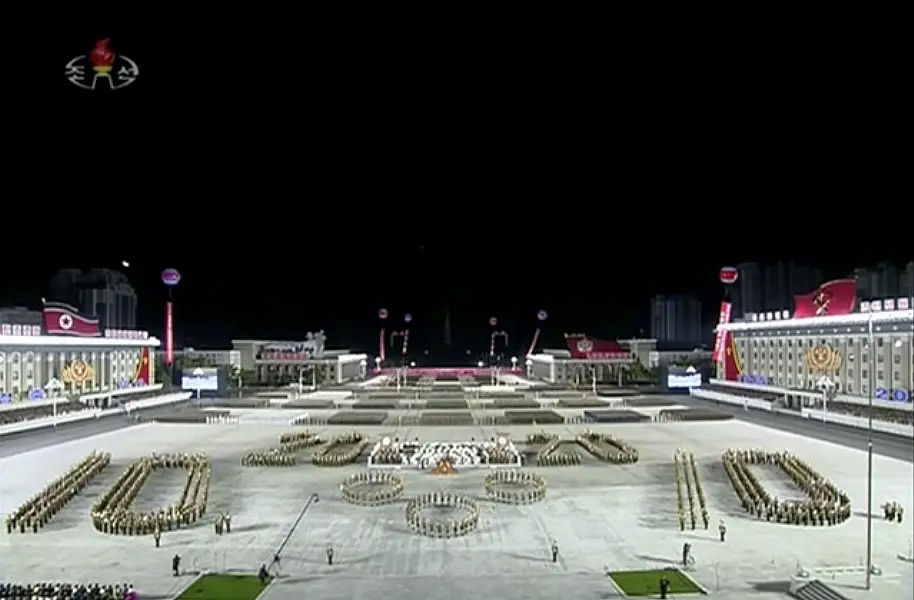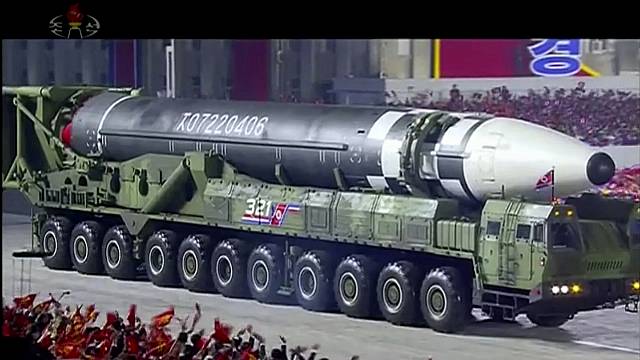The parade was used to unveil what appeared to be a new intercontinental ballistic missile (ICBM) and other additions to the country’s growing weapons arsenal.
Mr Kim, however, avoided direct criticism of Washington during the event, which took place less than four weeks before the US presidential election.
Instead, he focused on a domestic message urging his people to remain firm in the face of “tremendous challenges” posed by the coronavirus pandemic and crippling US-led sanctions over his nuclear programme.

Mr Kim described the North’s continuing efforts to develop its nuclear deterrent as necessary for its defence and said it was not targeting any specific country with its military force.
But “if any force harms the safety of our nation, we will fully mobilise the strongest offensive might in a pre-emptive manner to punish them”, he said.
His speech was punctuated by thousands of goose-stepping troops, tanks, armoured vehicles, rocket launchers and a broad range of ballistic missiles rolled out in Pyongyang’s Kim Il Sung Square.
The weapons included what was possibly the North’s biggest-yet ICBM, which was mounted on an 11-axel launch vehicle that was also seen for the first time, and a presumptive new solid-fuel weapon that could be an advanced version of a North Korean missile designed to be fired from submarines.
They highlighted how the North has continued to expand its military capabilities amid a stalemate in nuclear negotiations with the Trump administration, which prompted Mr Kim to pledge in December that he would continue to bolster his nuclear arsenal amid “gangster-like” US pressure and soon unveil a “new strategic weapon to the world”.
South Korea’s Joint Chiefs of Staff had said early on Saturday that there were signs that the North had mobilised “large crowds and equipment” for a military parade at Kim Il Sung Square during the early morning hours. In the evening, North Korean state television began airing a taped broadcast of the event, which began late Friday.
Troops were seen marching in the streets in front of the brightly illuminated square, as a military band performed while moving in formation.

The performers and tens of thousands of spectators roared as Mr Kim, dressed in a suit and tie, appeared from a building as the clock struck midnight. Mr Kim, flanked with senior officials and smiling widely, waved to the crowd and kissed children who presented him with flowers before taking his spot on a balcony.
During his speech, he repeatedly thanked his “great people” for overcoming “unexpected” burdens and abiding by the anti-virus measures imposed by the ruling party and government to keep the country free of Covid-19, a claim that has been widely questioned by outside observers.
He also extended an olive branch to rival South Korea, expressing hope that the countries could repair bilateral ties once the threat of the pandemic is over. The North had suspended virtually all co-operation with the South amid the stalemate in larger nuclear negotiations with the United States.
After his speech, Mr Kim waved and watched with binoculars as the military hardware was rolled out in the square. He saluted as fighter jets flew in formation above head, using fireworks to form the Workers’ Party symbol — a hammer, brush and sickle — and the number 75 in the sky.
It is unusual for the North to hold a military parade during the dark pre-dawn hours, although such conditions may provide benefits in protecting sensitive information about crucial weapons that were rolled out.
Earlier Saturday, masked citizens lined up to lay flowers at the statues of Kim Il Sung and Kim Jong Il, the father of the current ruler, at Pyongyang’s Mansu Hill. A huge street poster read “Best glory to our great party”.







